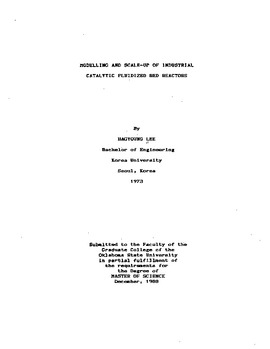| dc.contributor.advisor | Johnson, Marvin M. | |
| dc.contributor.author | Lee, Hagyoung | |
| dc.date.accessioned | 2015-08-19T16:06:10Z | |
| dc.date.available | 2015-08-19T16:06:10Z | |
| dc.date.issued | 1988-12-01 | |
| dc.identifier.uri | https://hdl.handle.net/11244/15640 | |
| dc.description.abstract | The fundamental problem involved in the design of a gas-solid catalytic reactor is defining the reactant gas concentration as a function of position within the reactor. For fluidized bed reactors, the problem becomes very difficult because the gas flow is split into two distinct phases: a fast moving bubble phase that largely bypasses the catalyst and a slower moving dense or emulsion phase that surrounds the catalyst. For fluid beds, the design problem becomes one of defining the concentration of the reactant in the emulsion phase as a function of position, determining the fraction of the total gas in the emulsion phase and closely estimating the transfer of reactant by mass transport between the bubble and emulsion phases. This interphase transport is a function of the bubble size. The Bubble Assemblage model proposed by Kato and Wen is one of the better models and it solved many of the problema associated with the constant bubble size models used in earlier work. However, this model has several insufficiencies. The first weakness in the Kato-Wen Bubble Assemblage model lies in the assumption that the percolation of gas through the dense phase can be neglected. This treatment consistently results in low estimates of the overall conversion in a fluidized bed reactor, especially in a bed of large fast bubbles where a substantial fraction of the cas flows through the emulsion phase. The second inadequency of the Kato-Wen model is that complete mixing ia assumed in each phase, which results in overest~ation of the overall conversion in the bed. The third insufficiency of the model is that it neglects the effect of reactor diameter on bubble velocity which ia an ~portant factor in the desicn of a fluidized bed reactor. The last insufficiency of the Bubble Assemblage model is the inclusion of a cloud volume within bubbles which is very small under the nor.mal industrial operating conditions. A new fluidized bed reactor model is developed in order to resolve the design problems mentioned above. The new models basis is a different assumption regarding gas mixing in each compartment. The height averaged concentration in each phase which is a new concept regarding the gas mixing .is included in the new model. The height averaged concentrations are predicted using the non-unifor.m spaced Euler method. In this new model, the average fractions of bubble and emulsion in each compartment are allowed to vary in each cell along the bed. The new model also incorporated the most recent bubble velocity correlation. ftodel predictions are in reasonably good agreement with experimental results which were obtained under the operating conditions, Umf > 0.5 cm/s. The present study also presents a suggested method for the prediction of emulsion gas voidace in a fluidized bed. | |
| dc.format | application/pdf | |
| dc.language | en_US | |
| dc.publisher | Oklahoma State University | |
| dc.rights | Copyright is held by the author who has granted the Oklahoma State University Library the non-exclusive right to share this material in its institutional repository. Contact Digital Library Services at lib-dls@okstate.edu or 405-744-9161 for the permission policy on the use, reproduction or distribution of this material. | |
| dc.title | Modelling and Scale-up of Industrial Catalytic Fluidized Bed Reactors | |
| dc.type | text | |
| dc.contributor.committeeMember | Johannes, Arland H. | |
| dc.contributor.committeeMember | Erbar, Ruth C. | |
| osu.filename | Thesis-1988-L4773m.pdf | |
| osu.accesstype | Open Access | |
| dc.description.department | Chemical Engineering | |
| dc.type.genre | Thesis | |
